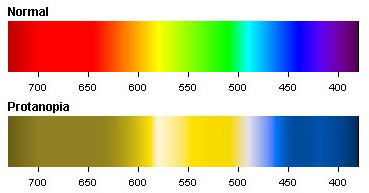Red-green color blindness is split into two different types: Whereas people affected by protan color blindness are less sensitive to red light, deuteranopia or deuteranomly (the second type of red-green color blindness) is related to sensitiveness on green light.
| Gender | Protanopia | Protanomaly |
| Male | 1.01% | 1.08% |
| Female | 0.02% | 0.03% |
Protans have either defective long-wavelength cones (L-cones) or the L-cones are missing at all. If they are missing it is called protanopia or sometimes red-dichromacy. Affected persons are dichromats because they have only two working cone types, short- and medium-wavelength, compared to persons with normal vision with three different cone types.
If the L-cones are defective they appear in different intensities. This results in either a stronger or a weaker color blindness. If L-cones are not missing but defective it is called protanomaly. People suffering from this kind of color blindness are called anomalous trichromats.

Protans have difficulties to distinguish between blue and green colors and also between red and green colors. When comparing the two spectrums you can see that there are different colors and shades of colors which are hard to distinguish for a protanopic person. So those persons are not only blind on red and green colors but a lot more. This means the well known term red-green color blindness is actually misleading and gives a wrong impression of protan color blindness (and also deutan color blindness).
Protanopia and protanomaly both are congenital color vision deficiencies. Their cause is an unequal recombination in the gene array which is passed on thereafter from parents to their children.
The genes encoding the L-cone photopigments are located on the X chromosome. This chromosome is also called the sex-chromosome, because women have two X’s compared to men with only one X combined with Y chromosome. If something is encoded on the X chromosome it is called sex linked. Sex linked traits are more often observed on men than women because a woman always has a second X chromosome which can compensate the deficiency. This unbalance between men and women can be seen in the table above showing the ratios of each kind of protan color blindness.

 Some rights reserved.
Some rights reserved.There are a number of studies which show that color vision deficiencies are a serious risk factor in driving. Particularly protan color blindness reduces substantially the ability to see red lights, regardless of the severity of the defect. Tests showed that protans were very much over-represented in an accident causing group of drivers mostly involving either signal lights or break lights. Some scientists estimate that being a protan has associated with it a level of risk of road accident that is equivalent to having a blood alcohol level of between 0.05 and 0.08 per cent. Because of that for example in Australia you can’t get hold of a commercial drivers licence since 1994 if you are suffering from protanopia or protanomaly.
Read more about Tritanopia and Deuteranopia—the other two types of color blindness.
Further reading:
Opsin Genes, Cone Photopigments, Color Vision, and Color Blindness
Protan Colour Vision Deficiency and Road Accidents
Wikipedia: Color Blindness
Related articles:
The Biology Behind Red-Green Color Blindness
Colorblind Population
At The Traffic Light
